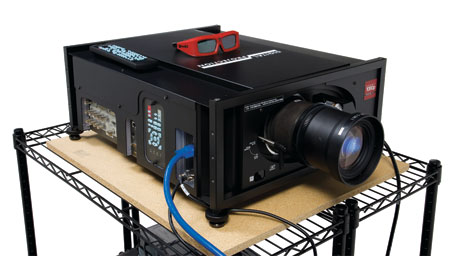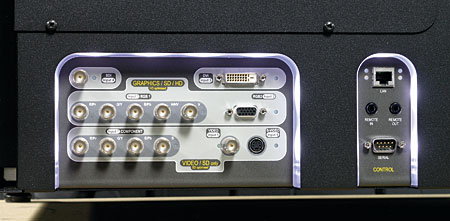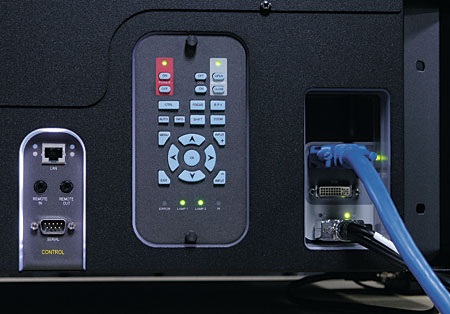Digital Projection Titan 1080p 3D Page 2
For 2D, that near-50-ft-L output means that you can watch news, weather, and sports in a fairly bright room (as long as the light doesn’t fall directly on the screen) without feeling deprived. However, for 2D movie viewing, you’ll get the best results—and the most comfortable-to-watch picture (assuming a screen of roughly the same size I used)—in a fully darkened room with just one lamp engaged.

In single-lamp mode, I measured a 2D peak brightness of 21 ft-L. The 2D black level with one lamp measured 0.007 ft-L (for a full-on/full-off contrast ratio of 3,000:1). This isn’t up to the standards set by the best non-DLP home projectors from the likes of JVC and Sony, but it’s comparable to a good DLP home projector that lacks a dynamic iris. The Titan has no adjustable iris of any kind. That black level doubles with two lamps fired up—to 0.014 ft-L, for a full-on/full-off contrast ratio of 3,392:1 (47.49 ft-L/0.014 ft-L). But when you throw on your 3D glasses, the black level at your eyes will drop along with the overall perceived brightness.
The bottom line is that the Titan’s overall contrast ratio and black levels are impressive considering the exceptional peak white levels the projector offers. However, I wouldn’t consider using a much smaller screen than ours, as this will produce much higher black levels. A lower-gain screen would help compensate for this, if you really must go smaller. It’s also possible to use the Titan with a larger screen, as is often necessary in the pro venues where this projector earns most of its keep. However, this will sacrifice some image punch, particularly with 3D. All things considered, I believe a 10-to-12-foot-wide screen with a gain of around 1.3 to be optimum with this projector for home use, offering a comparable brightness, black level, and contrast ratio in both 3D (with two lamps) or 2D (with just one). A 10-foot size is about right for any sensible home theater—unless you regularly invite dozens of guests to enjoy movies in your ballroom.

The Titan has two sets of DVI digital inputs. There are no HDMI inputs, as HDMI is primarily a consumer format. For video-only connections, an HDMI-to-DVI breakout cable works fine. One of the DVI inputs (input 8) has two separate DVI connections. This will accommodate sources that require more data throughput than the 3D sources that are generally available to the consumer (remember that the Titan was designed as a professional projector). You’ll only need one of those jacks for consumer sources, which is how I used it.

The other DVI input (input 3) has only a single DVI jack. This second input offers video processing, while the dual DVI input—even when used with a single DVI connection—is straight passthrough with no processing or scaling of any kind. The video processing at input 3 is middling at best and inferior to what’s in most of the consumer flat panels we’ve tested. But then, most installations with this type of projector are likely to include an external processor.
The Creature from the Black Lagoon
Arrayed in any color as long as it’s textured black, the Digital Projection Titan is
one ugly beast. And it’s very noisy. But
this kind of projector is clearly meant for no-expense-spared, screening-room-sized installations where the projector will be far away from the audience, who will neither see nor hear the unit when it’s at work. Form follows function, and clearly the only design goal here was to create the finest projected image possible.
And does it ever. Bigger digital projectors (yes, there are bigger ones) may put out more light for giant theater screens, but I doubt that any of them produce superior results. Some home theater projectors produce significantly deeper blacks, but I’ll be surprised if any of the home 3D models that we’ll inevitably see will come anywhere near the Titan’s 3D bright- ness levels—or at least not at prices likely to encourage significant sales.
 A lot of credit must go to the Titanic projection lens from Minolta. The wholesale cost of that lens alone would likely buy you a brace of good home projectors. But I’ve never seen resolution as good as the Titan’s from any dedicated home theater projector. Great optics rule, and as any professional photographer will tell you, great optics cost serious money. Yes, the lenses on those cheaper projectors do a surprisingly good job, but the best lenses can really make a difference.
A lot of credit must go to the Titanic projection lens from Minolta. The wholesale cost of that lens alone would likely buy you a brace of good home projectors. But I’ve never seen resolution as good as the Titan’s from any dedicated home theater projector. Great optics rule, and as any professional photographer will tell you, great optics cost serious money. Yes, the lenses on those cheaper projectors do a surprisingly good job, but the best lenses can really make a difference.
If I have any criticism about the Titan’s resolution, it’s that the chip alignment (red, mainly) was off by about a half pixel. There’s no pixel-shift feature. But I couldn’t see this displacement from a reasonable viewing distance. It’s also possible that this particular sample has endured more than the usual shipping knocks that come from going around the block a few times. This unit served on the show floor of the INFOCOM trade show in Las Vegas, before it shipped back to Digital Projection in Georgia for a QC check and then all the way back to our West Coast lab. That’s a lot of bumpy miles.
I had no serious qualms about the Titan’s color. There are a number of different color controls to optimize the gray scale (and the gamma). After I dialed it in with the User controls (which offer both Lift—that must be British for Offset, Bias, and elevator—and Gain for red, green, and blue), the color tracking was the best I’ve ever seen. The three colors that make up our usual color-tracking chart overlaid so closely that it was hard to see them as three separate lines. The Delta E was under 0.5 from 30 IRE (dark) to 100 IRE (peak white) and a maximum of just over 1 at 20 IRE (very dark). (Delta E is a figure of merit that indicates how closely the color balance adheres to the D65 standard. Any value under 3 is generally considered to be excellent.)
There’s also an option for selecting a fixed color setting, with options from 3,000 Kelvins to 10,000K in 100-Kelvin steps. Surprisingly, I found that the setting that came the closest (and very close, at that) to the D65 standard was 8000K with two lamps engaged and 7500K with just one. As this indicates, the color temperature differs slightly with one lamp on versus two. The projector offers presets for multiple setup memories including color in input 3, but not in input 8.
Keep in mind that for 3D displays that don’t have a 2D-to-3D conversion mode (and the Titan does not), we can only perform a 2D calibration since we don’t yet have 3D test patterns. Once the Titan was calibrated in 2D, I didn’t see any significant color shifts when it went to 3D.
As delivered, the Titan’s color gamut was too wide, particularly in green and red. This may be the current fashion in con- sumer displays, but a professional projector should be able to do better. And the Titan can. Digital Projection offers a computer software program that can configure the color gamut to virtually any desired end. We weren’t able to check this out, and feedback from the field indicates that using it involves a rather steep learning curve. If the projector’s gray-scale tracking is any indication, an experienced calibrator should be able to use this feature to nail the Rec. 709 HD color gamut standard dead to rights.
- Log in or register to post comments




































































